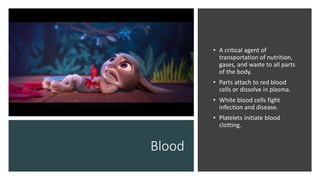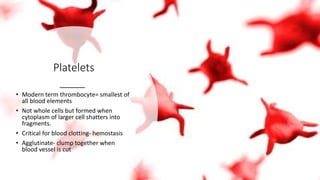Blood and lymphatics
- 2. Blood • A critical agent of transportation of nutrition, gases, and waste to all parts of the body. • Parts attach to red blood cells or dissolve in plasma. • White blood cells fight infection and disease. • Platelets initiate blood clotting.
- 3. Blood Components • Blood is a mixture of • Plasma • Formed Elements • Erythrocytes= Red Blood Cells • Leukocytes= White Blood Cells • Platelets
- 4. Production • Hematopoiesis= blood cell production by red bone marrow • Red bone marrow most abundant in children • Adults have more yellow marrow than red
- 5. Plasma • 55% of adult whole blood supply • 90-92% is water • 8-10% is dissolved substances: • Plasma proteins • albumin-transport fatty substances • Globulin- type of antibody • Fibrinogen- blood clotting protein • Ca, K, Na, glucose, amino acids, and fats are also transported via plasma
- 6. Erythrocytes • Red Blood Cell • Not a true cell- no nucleus • Hemoglobin creates red color • this is what picks up oxygen from lungs to deliver to tissue. • Lifespan of 120 days • Spleen removes worn-out/damaged RBC
- 7. Leukocytes • White Blood Cells • True Cell • Provides protection against pathogens like bacteria and viruses
- 8. 5 Types of Leukocytes • Granulocytes- granules in cytoplasm • Basophiles- histamine and heparin release • Eosinophils- destroys parasites- high in allergic reactions • Neutrophil- phagocytize foreign and damaged cells • Agranulocytes- no granules • Monocyte- phagocytize foreign and damaged cells • Lymphocytes- several roles in immune response
- 9. Platelets • Modern term thrombocyte= smallest of all blood elements • Not whole cells but formed when cytoplasm of larger cell shatters into fragments. • Critical for blood clotting- hemostasis • Agglutinate- clump together when blood vessel is cut
- 10. Blood Types • Blood differs because of presence of antigens or markers on RBC • Type: • A • B • AB= universal recipient • O= universal donor
- 11. Rh- Factor • If present, then Rh+ (Type A+, B+, AB+, O+) • Not present then Rh- (A-, B-, AB-, O-) • Rh + can have blood transfusion for positive and negative Rh • Rh- can only have transfusion for negative Rh-
- 12. Lymphatics • System composed of: • Lymphatic Vessels • Lymph Nodes • Spleen • Thymus • Tonsils • Fluid in system is called lymph • Serves at body primary defense system
- 13. Network • Lymphatic Vessels- network of ducts, one way system • Lymph Nodes- small organs/ glands that acts like a filter to remove pathogens and debris • Tonsils- each side if throat. Lots of leukocytes. Filters to protect body digestive and respiratory. • Spleen- filters blood • Thymus Gland- development of immune system
- 14. Immunity • Body ability to defend itself from pathogens • Natural immunity/ innate immunity • What the body already is equipped with- ie macrophage • No exposure to disease or pathogen • Acquired immunity • Body response to specific pathogen
- 15. FIN














